The Latest: International Education Week with IIE’s Open Doors 2020 Report
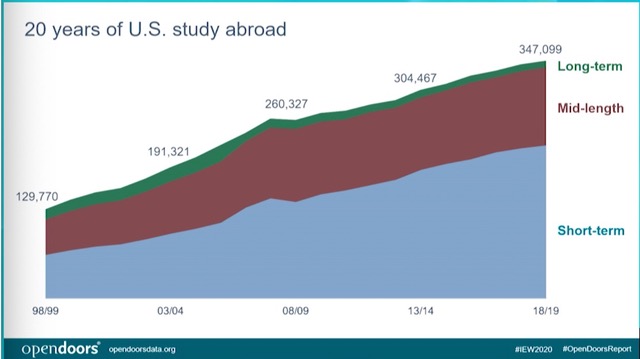
The pandemic has turned our lives upside down and inside out, roiling our daily life patterns and presumptions. Even the simplest things, like going out for a meal, have changed drastically. So what does it mean for study abroad? Since last spring, most study abroad programs have been on permanent hold because of closed borders and individual countries managing their own COVID19 responses. Some programs may begin again in the spring, but most everyone in the field seems to think that summer is the earliest and fall is a hopeful best-case scenario.
So as the latest data was released last Monday by the Institute of International Education (IIE), in partnership with the Bureau of Educational and Cultural Affairs and the U.S. Department of State, the annual Open Doors 2020 report showcases data supporting the increasing internationalization of higher education–but for the 2019-2020 academic year, pre-pandemic.
Read on with that in mind.
In a survey of almost 3,000 U.S. higher education institutions that hosted international students, IIE published its annual report on the 2019-2020 academic year, which notably does not reflect the impact of the COVID-19 pandemic. It is important to highlight that we don’t yet know what type of impact the pandemic will have on international students coming to the U.S. and the ability for Americans to study abroad. With that said, if trends continue as they have over the past two decades, the years to come will have the largest and most diverse batch students studying around the globe.
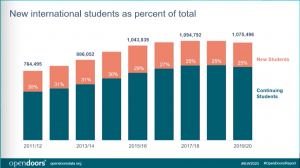
Over the past 10 years, the number of international students in the U.S. has nearly doubled, yet growth has been stagnant in the recent five years, including a 1.8% decrease most recently. The decline can be explained by increased global competition, expanding educational capacity in home countries, shifting demographics and government scholarship programs. Still, the U.S. remains the top country to host international students worldwide— largely in part due to efforts from the U.S. higher education to attract and welcome international students.
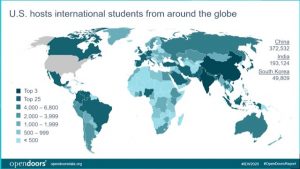
China, India and South Korea, respectively, make up the top three countries from which international students come to the U.S. Together, China and India make up 53% of all these students. Yet students come from every country around the world to form 5.5% of all those in U.S. higher education. These students bring $44 billion in revenue to the U.S. economy, primarily through education funding— five times what this figure was 20 years ago, demonstrating the significant impact globalization has had on the educational sector of the American economy. The most common fields of study for international students are, in order: STEM, Business and Management and Social Sciences.
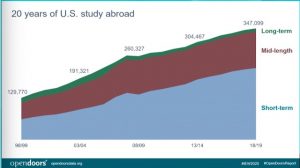
In addition to dramatic increases in international students coming to the U.S. for education, greater numbers of Americans have pursued study abroad experiences. Between fall of 2018 and summer of 2019, 347,099 students received academic credit abroad— a number that has more than doubled in the past two decades. This figure has mostly been driven upward by increasing opportunities for short-term study abroad, allowing more students to take part in an experience that will enhance their cross-cultural skills and open their minds to new ways of thinking about the world.
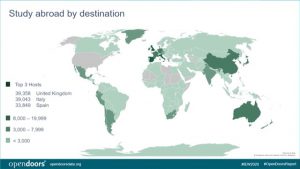
Of these Americans studying abroad, 56% choose Europe as their destination. More specifically, one in three students goes to the United Kingdom, Italy or Spain. Although Europe has been the destination of choice for decades, recently there have been increases in all world regions. Asia, for one, has seen five times the number of American students than 20 years ago. All told, 11% of all undergraduates in the U.S. will opt to study abroad. The most popular majors to go abroad remain business and management and the social sciences. Recent efforts have attempted to encourage more STEM students to go abroad by finding sufficient curriculum requirements in other countries.
In addition to encouraging a greater number of majors to study abroad, U.S. higher education has also supported greater diversity amongst students. Now, 31% of students who go abroad consider themselves a racial or ethnic minority, as opposed to 15% two decades ago. Moreover, 38,120 students traveled abroad for non-credit experiential activities, a third of whom volunteered. However, since universities reported this data, this number is likely severely uncounted as students often don’t declare their activities if they cannot receive credit.
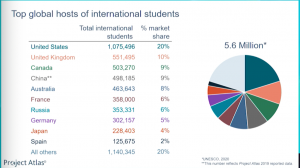
With a broader outlook of international students receiving their educations in other countries, IIE’s Project Atlas further contextualizes the Open Doors data. Of the 5.6 million students studying in different countries, 20% choose the U.S. The main motivations for this decision include access to high-quality higher education, affordability, improved employability and personal and professional growth. Above all, it is clear that the U.S. plays an important role in global research and international higher education and continues to foster a culture that expands internationalization both by bringing more international students to the U.S. and sending more Americans abroad.
This year’s International Education Week theme encourages students to continue to be engaged, resilient and global because they are the key to enriching our classrooms, businesses and politics for the future. This applies to international students as well: Continue to look to the USA as a place to bring your myriad of talents to apply, share and study with American students. US higher education needs as much globalization as possible and, with a new Biden-Harris Administration, things will most likely look a lot different. Here’s hoping. For more information explore data online. #GoGlobal!
